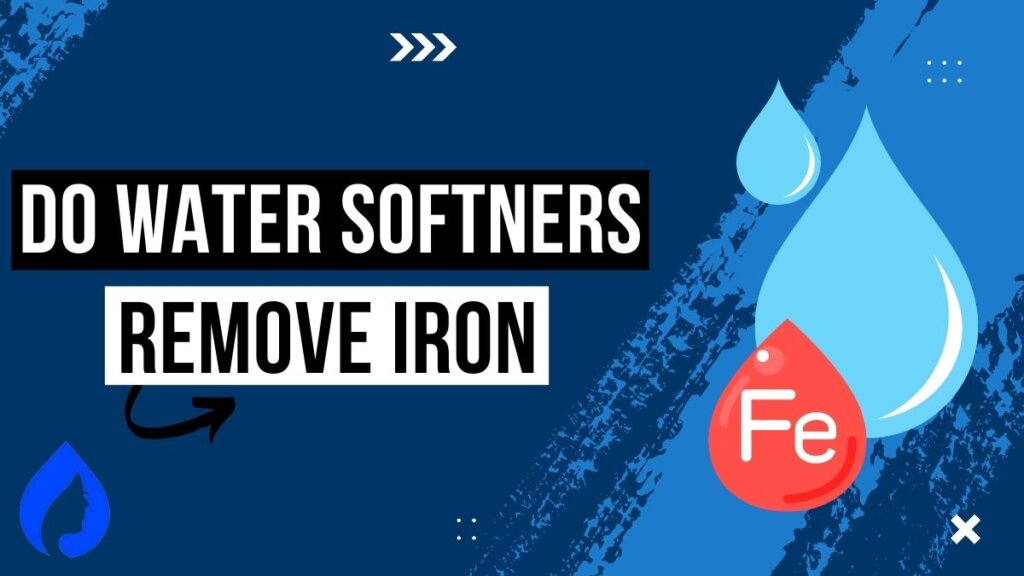
Does your water taste metallic and leave ugly stains on everything, even after installing a water softener?
Water softeners turn hard water into soft water by removing calcium and magnesium salts using the ion-exchange technology.
But if you want to remove iron, then no, a water softener isn’t a good choice.
This is because water softeners have only 1 ppm or 1 mg/l of iron removal capability, a very small amount compared to the higher iron levels found in most US regions, ranging from 15 to 20 ppm.
So what will remove high levels of Iron? Continue reading to find out!
🤔Why Is My Water Softener Not Removing Iron?

A basic water softener consists of a resin tank and uses an ion exchange process to remove calcium and magnesium from hard water. However, it may also remove a small amount of iron.
Resin beads are the main component of the water softener system.
The resin beads exchange calcium and magnesium ions carrying a positive charge with potassium and sodium ions carrying a negative charge, from the water supply. Hence, decrease hardness levels from water.
But what about iron? Two forms of iron are present in water:
Iron in concentrations as low as 0.3 ppm is sufficient to stain or discolor household items.
Ferrous iron is adsorbed at the resin bead, decreasing the regeneration cycle period of the softener resin bed.
Hence, an effective solution is needed to flush out the waste from the filter. On the other hand, ferric iron does not chemically adsorb on resin beads and flows with the water.
These water softeners do not have iron filters to eliminate iron bacteria, exposing your water to disease-causing organisms.
Also Read: Why My Water Softener Is Full Of Water?
🎯How To Remove Iron From Water At Home: Best Ways

Three main types of iron contamination can be present in your well water sources, making it unfit for consumption.
Let’s go through them and understand how we can resolve them.
Before that, it is best to first test your well water quality to determine which form of iron is causing problems and then opt for a suitable water treatment solution for the removal of iron.
The yellow tap water test is one of the trusted methods that give instant results in 5 days.
This test provides a thorough and detailed analysis of common metal contaminants, minerals, and tannins that may lead to water discoloration.
👉Ferrous (Clear Water) Iron
Ferrous iron is the soluble iron present in water. It is not visible to the naked eye. Hence, it is known as clear or soluble ferrous iron water.
Also Read: Do Water Softeners Remove Fluoride?
👉Ferric (Reddish Brown Water) Iron
Ferric iron is the insoluble iron present in water. It is visible to the naked eye and presents as an insoluble mass.
Manganese greensand filters are used for iron filtration and remove high levels of both ferrous and ferric iron from the water, making it fit for consumption.
Also Read: Do I Need Water Softener With City Water?
👉Iron Bacteria

Iron bacteria create a favorable niche for other bacteria to replicate significantly, increasing the health risk.
These bacteria also produce a slimy gunk that clogs the pipes and leads to a reduction in flow rate and a drop in water pressure.
Also Read: How Water Softeners Are Different From RO?
💡Do Water Softeners Remove Iron FAQs
How much iron will a water softener take out?
A typical water softener system can remove up to 1 ppm of excess iron concentration from the water supply.
However, groundwater supplies in most American states have higher iron levels, ranging from 15 ppm to 20 ppm. Hence, it is not a great choice to proceed with.
Do I need an iron filter if I have a water softener?
Yes, if you have more than 1 ppm of soluble or insoluble iron, you need to treat water with an iron filter along with a salt-based water softener.
This option can give you iron-free soft water, making it fit for consumption.
How do you know if you have too much iron in your water?
Several techniques are used to find concentrations of iron in drinking water.
If it has a metallic taste, an awful odor, and a reddish-yellow appearance, then one can be sure to have high iron content in water.
What does iron water do to your hair?
Bathing in iron water is not advisable as it damages your healthy hair, making it dry, weak, frizzy, and even resulting in hair fall.
Is it OK to drink water with high iron?
Yes, it is OK to drink water with high amounts of iron as it is an essential mineral.
The body needs iron for many functions, including the transportation of oxygen throughout the body, so drinking water that contains iron is not harmful to your health.
However, more than 0.3 ppm of iron in water can cause a weird metallic taste, altering the flavor, aroma, and odor of beverages and vegetables cooked with it.
It can also harm hair and skin.
Adarsh is a Health & Nutrition Sciences graduate with expertise in environmental health. He is associated with ventures like Glacier Fresh Filter and Simpure Filter Systems. Through Aqua Professor, he intends to provide helpful information to every home to help them make smarter decisions.
